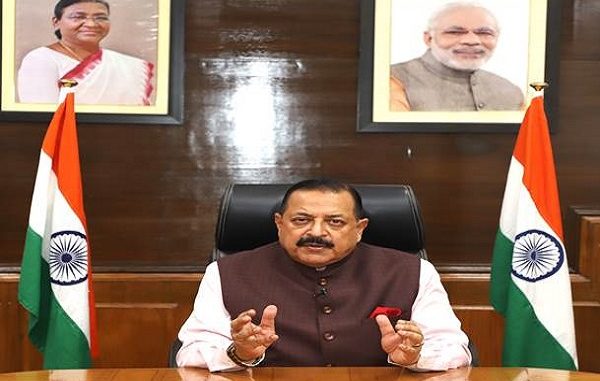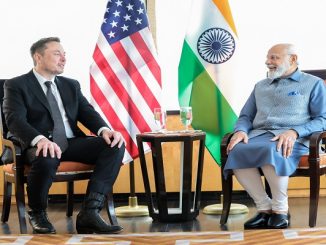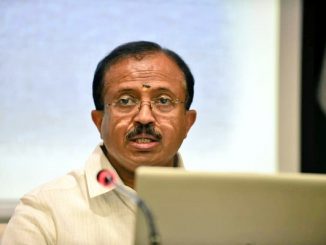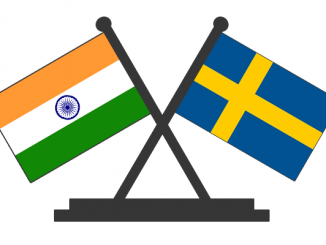
Aug 07: Union Minister of State (Independent Charge) Science & Technology; MoS PMO, Personnel, Public Grievances, Pensions, Atomic Energy and Space, Dr Jitendra Singh today said, BRICS (Brazil, Russia, India, China and South Africa) should continue to hold global significance for being the most populated marketplace, driven by the knowledge, creativity and innovation economy.
Addressing the 11th BRICS STI Ministerial Meeting at Goeberha in South Africa through a virtual medium on “STI priorities and policies updates”, Dr Jitendra Singh said, the grouping could collaborate to identify and explore regional scientific-research challenges through joint S&T solutions suited to local economies.
Dr Jitendra Singh said India would support BRICS efforts in developing innovative and inclusive solutions including digital and technological tools to deepen science and technology cooperation in the areas like Health, Agriculture, Water, Marine Sciences, Renewable Energy, Biotechnology, Advanced Digital Technologies and Environment etc. to promote sustainable development and facilitate affordable and equitable access to global public goods for all. He said, India looks forward to working closely to enhance the BRICS collaboration in the field of Science, Technology and Innovation.
Dr Jitendra Singh said India has been steadily progressing ahead along the mantra emphasized by Prime Minister Shri Narendra Modi on ‘Jai Jawan, Jai Kisan, Jai Vigyan, and Jai Anusandhan,’ to establish its footprint in the research and innovation landscape at the global level. This has paved the way for a resounding success. India has now scaled up to 40th position as per Global Innovation Index (GII) 2022 as compared to 81st position in 2015. India is placed among the top 3 countries in terms of the number of scientific publications as per the NSF database; in the context of the number of PhDs, the magnitude of the higher education system; as well as with respect to the number of technology start-ups and a number of unicorns, the Minister added.
Dr Jitendra Singh said the National Research Foundation approved by the Modi Cabinet will ensure that scientific research is funded equitably and greater private participation is forthcoming. For this NRF will have to nudge companies to invest in R&D. We are planning a unique Public Private Partnership (PPP) entity for which ₹36,000 Cr of the research funding is to come from the private sector, mostly industry whereas Government will put ₹14,000 Cr for the same, to ensure greater participation of industry, the Minister informed.
NRF has also been given the task of creating a policy framework and working on regulatory processes. Several disciplines have to work together to develop evidence-informed, context-relevant, resource-optimising, culturally-compatible and equity-promoting solutions. Besides the NRF, there have been a substantial number of other initiatives that we have undertaken to encourage our researchers to work in basic and applied research addressing the various Sustainable Development Goals. Thus, with an ever-increasing horizon of research activities, it is pertinent not only to address scientific research but also to work from end-to-end worksheets to embrace the challenge. This includes comprehending research challenges, raising the technology readiness level (TRL), provide the business readiness level (BRL) for newly developed technology products. This can only be achieved through applications of new and emerging technologies.
Given below is the full text of the speech: –
- H.E. Ministers from the BRICS Member States
- Leaders of the Delegations
- Dear Colleagues, Esteemed Delegates and Friends,
I would have loved to join you in person and meet my colleagues from BRICS Member States. However, because of the ongoing parliamentary session in India, I am addressing you through a recorded video message.
2. India has been steadily progressing ahead along the mantra emphasized by Prime Minister Shri Narendra Modi on ‘Jai Jawan, Jai Kisan, Jai Vigyan, and Jai Anusandhan,’ to establish its footprint in the research and innovation landscape at the global level. This has paved the way for a resounding success. India has now scaled up to 40th position as per Global Innovation Index (GII) 2022 as compared to 81st position in 2015. India is placed among the top 3 countries in terms of the number of scientific publications as per the NSF database; in the context of the number of PhDs, the magnitude of the higher education system; as well as with respect to the number of technology start-ups and number of unicorns.
3. During the last seven years, India’s expenditure on R&D has almost doubled. In this year’s budget, we have allocated about Rupees 16,360 Crores (~US$ 2.20 billion) for the Ministry of Science and Technology. This apart, Govt. of India has recently embarked upon the creation of a National Research Foundation (NRF) with substantial funding to promote translational and interdisciplinary research in addition to basic R&D activities.
4. In India, currently research is conducted in silos – in government departments and laboratories, central and state educational institutes – with no uniformity in infrastructure. We propose NRF to seed, grow and promote research & development (R&D) and foster a culture of research and innovation throughout Indian universities, colleges, research institutes etc. The NRF is to ensure that scientific research is funded equitably and that greater private participation is forthcoming. For this NRF will have to nudge companies to invest in R&D. We are planning a unique Public Private Partnership (PPP) entity for which ₹36,000 Cr of the research funding is to come from the private sector, mostly industry whereas Government will put ₹14,000 Cr for the same, to ensure greater participation of industry. NRF has also been given the task of creating a policy framework and working on regulatory processes. Several disciplines have to work together to develop evidence-informed, context-relevant, resource-optimising, culturally-compatible and equity-promoting solutions
5. Besides the NRF, there have been a substantial number of other initiatives that we have undertaken to encourage our researchers to work in basic and applied research addressing the various Sustainable Development Goals. Thus, with an ever-increasing horizon of research activities, it is pertinent not only to address scientific research but also to work from end-to-end worksheets to embrace the challenge. This includes comprehending research challenges, raising the technology readiness level (TRL), provide the business readiness level (BRL) for newly developed technology products. This can only be achieved through applications of new and emerging technologies.
6. The underlying foundation to boost seminal R&D activities includes the creation of state-of-the-art infrastructure facilities across the nation. Govt. of India has launched innovative schemes like SATHI (Sophisticated Analytical & Technical Help Institute) and SUPREME (Support for Up-gradation Preventive Repair & Maintenance of Equipment) that ensures set-up of major analytical instrumentation and advanced manufacturing facility that can be readily accessible to researchers across academia, start-ups, manufacturing units, industries and R&D Labs besides ensuring a mechanism for minimizing downtime and optimal utilization of these facilities by facilitating the scope for repair/ upgradation/ maintenance and retrofitting.
7. For ensuring transparent access, optimal utilization and geographical spread, a dedicated National Portal, I-STEM, has been launched that is the gateway for researchers to locate the specific facility(ies) pertaining to their research needs.
Let me give you examples of developments in some specific sectors:
Biotechnology Sector
8. India has launched several seminal programs with diverse portfolio from the development of vaccines, Gene therapy, the National Biopharma Mission, infectious diseases to lifestyle diseases, etc. that has played a pivotal role in establishing a strong ecosystem for Life Sciences R&D in the country. India has adopted a multifaceted approach in the development of innovative technologies, better varieties of agricultural crops, animal, and dairy products as well as marine resources. Various programs are aligned with UNSDG-2030 such as Zero Hunger, Good Health and Well-being, Affordable and Clean Energy, Industry, Innovation and Infrastructure, and Climate Action for Good Health and Well-being of every age group of the Indian population. Formulation of four COVID-19 vaccines (i.e., ZyCoV-D, CORBEVAXTM, GEMCOVAC-19™ and iNCOVACC) are shining examples of India’s achievements in this field.
9. India has galvanized the processes to provide economically viable sustainable technologies for alleviating under-nutrition, obesity and related pathologies, micronutrient deficiencies and foods for targeted populations that are both shelf-stable and sensorily acceptable. For making Healthcare Affordable, it has developed technologies for Generic, Repurposed and new molecule-based drugs through high-quality, cost-competitive intermediates and APIs, and Genomics, signifying India’s tag-line – “Pharmacy of the World” which was also evident during peak COVID time.
Digital World
10. India’s National Supercomputing Mission has created high-performance computing facilities in different institutions across India. The launch of the National Mission on Inter-Disciplinary Cyber-Physical Systems (NM-ICPS) has strongly aided technology development in diverse cyber physical fields like Robotics, and IoT through the setting up of Technology Innovation Hubs (TIH) at 25 different academic setups across the country, each focusing on a specific domain of the cyber-physical system, like Modern Digital Technologies, Robotics, Machine learning etc. The integration of advanced digital technologies and data analytics has helped improve decision-making processes, enhance productivity, and drive innovation in diverse industries.
11. Recently, a National Quantum Mission has been launched that aims to scale up scientific and industrial R&D, for accelerating Quantum Technology-led economic growth and leverage India into a leading nation supporting sustainable development. Developing quantum technologies, exploring quantum communication, cryptography, and quantum algorithms are our research priorities.
Clean Technologies
12. India’s energy generation depends on fossil fuel (59.8 per cent), with coal contributing to about 51 per cent. Even though renewable energy has grown to an impressive 38.5 per cent, there is still a pressing need to further decarbonise the energy sector. To address these challenges, India has launched a dedicated mission mode technology development program on Clean Energy, to have technology-led solutions for energy and environment challenges including materials for energy conservation and storage platform.
13. In this direction, the world has also witnessed the rise of several technology-based start-ups. To inculcate the start-up ecosystem, India has established a Clean Energy International Incubation Centre (CEIIC) under the Mission Innovation program. Numerous innovative clean energy solutions have been developed by start-ups established through this incubation centre. India is co-leading a Mission for undertaking and demonstrating high-performance bio-refinery systems with a target of reducing fossil-based fuels, chemicals and materials with bio-based alternatives by 2030.
14. With a steadfast commitment to environmental and climate issues, India has launched two Missions to address future energy needs and environmental concerns namely, a) Green Hydrogen Mission: Production, Utilization, Storage and Conversion, and b) Carbon Capture, Conversion, Storage and Utilization.
15. As we move towards a more sustainable future, we have been adopting cleaner technologies aiming for greener process methodologies in the leather industry; and eco-friendly chemicals, processes and waste management technologies for effective implementation for leather and other industry, and also materials encompassing metals, alloys, composites, ceramics etc. and also sustainable metal processing and extractions techniques for reducing carbon footprints during material extraction and manufacturing.
Blue Economy
16. By harnessing the potential of the Blue Economy, we can ensure the well-being of our oceans while driving economic development in a sustainable and responsible manner. It promotes the development of economic activities that maintain a balance between the economic, environmental, and social objectives and ensures the long-term sustainability of the ocean ecosystem. The Blue Economy approach is firmly rooted in SDG 14 (‘Life Below Water’) which aims to “Conserve and sustainably use the oceans, seas and marine resources for sustainable development”.
17. It is pertinent to enhance our scientific knowledge through collaborative research and innovation for sustainably utilizing the potential of Blue Economy, majorly from enhanced ocean observations and services, and marine spatial planning, especially for the BRICS Member States that are ocean-based economies. This assumes even more significance as oceans and marine ecosystems are major repositories of carbon and serve as natural barriers against coastal erosion, storm surges, cyclonic calamities, and sea level rise, and contribute towards climate change adaptation or SDG 13 on climate action.
18. India has disclosed its vision for the coming decade, listing the ten most important dimensions of its growth till 2030 and Blue Economy is envisioned as the sixth dimension to protect and conserve ocean resources for promoting sustainable development. The process of unveiling the Blue Economic Policy is underway and it is estimated that ocean-based industries would generate employment for nearly 40 million people.
19. Moving ahead with the Blue Economy Initiative, Deep Ocean Mission is being implemented, which includes the development of ocean and climate change advisory services to address climate resilience, exploration and conservation of deep-sea biodiversity, development of technologies for sustainable harnessing of ocean resources and capacity building.
20. The near real-time weather, climate and ocean forecast, and mitigation advisory services provided by India are vital in addressing the science of climate change and developing climate services including achieving food and economic security and promoting sustainable agricultural practices in the country. India also offers early warning information for severe weather phenomena and other hazardous events like tsunamis, extreme waves, cyclones, storm surges & flash floods, forest fire monitoring and identification of hotspots.
Research Incubation and Translation
21. The confluence of technologies and productive partnerships would revitalize the innovation dynamics and usher in a mechanism of collaborative circular economy. To boost the entire value chain of innovations a national programme titled NIDHI (National Initiative for Developing & Harnessing Innovations) has been launched. To ignite young minds to innovate, Prime Minister Narendra Modi’s vision has been the cornerstone behind the establishment of Atal Tinkering Labs to foster an ecosystem of innovation and entrepreneurship that has grown from zero to 10,000 across 700 districts in the last six years.
22. Technology Development Board (TDB) facilitates investment, scale-up innovations for promoting Indian Industries for indigenous technology development addressing nationally relevant product development & commercialization by way of setting up best-in-class manufacturing infrastructure in the country. The Board has been playing a pivotal role in supporting startups, innovators, and entrepreneurs to convert their innovations into market-ready products.
23. India has nurtured innovation and entrepreneurship by establishing a ‘Biotechnology Industry Research Assistance Council (BIRAC)’, to facilitate the development of several affordable biotech products and technologies. This has paved the way for a phenomenal number of more than 3500 start-ups in the last few years. These schemes have laid the foundation for strengthening the R&D capabilities of start-ups/ companies thereby, providing the desired impetus for pulling the translational ideas right from generating Proof of Concept to validation, scaling-up, demonstration and pre-commercialization of products and technologies.
Gender Equality
24. Towards achieving gender equality in Science, India has initiated various women-centric programs for promoting career opportunities for women scientists through diverse interventions. A special focus has been attached to encouraging and reinvigorating women researchers in STEM and Industrial R&D who have gone out of the system for various reasons. Through sustained efforts, we have been successful in doubling the number of women researchers in the last 10 years.
25. These are some of the major highlights of India’s STI priorities and policy updates. India is fully committed to contributing and cooperating in any form for the betterment of our society and planet Earth.
Strengthening BRICS STI Cooperation
- Excellencies, moving ahead with contemporary challenges, BRICS should continue to hold global significance for being the most populated marketplace, driven by the knowledge, creativity and innovation economy. BRICS Member States could collaborate to identify and explore regional scientific-research challenges through joint S&T solutions suited to local economies.
- India would support BRICS efforts in developing innovative and inclusive solutions including digital and technological tools to deepen science and technology cooperation in the areas like Health, Agriculture, Water, Marine Sciences, Renewable Energy, Biotechnology, Advanced Digital Technologies and Environment etc. to promote sustainable development and facilitate affordable and equitable access to global public goods for all.
- India looks forward to working closely to enhance the BRICS collaboration in the field of Science, Technology and Innovation.



